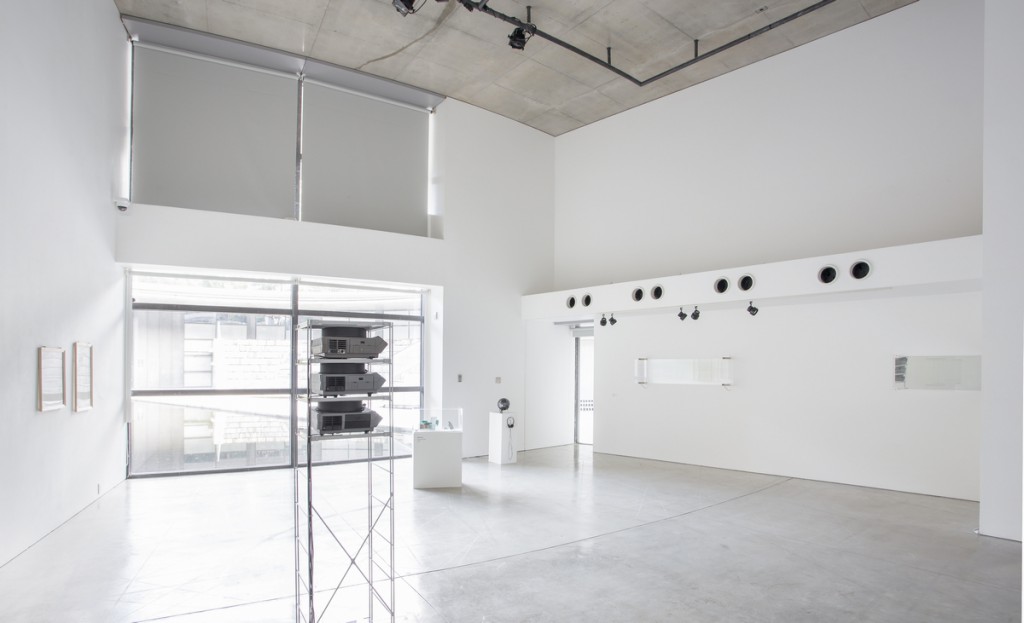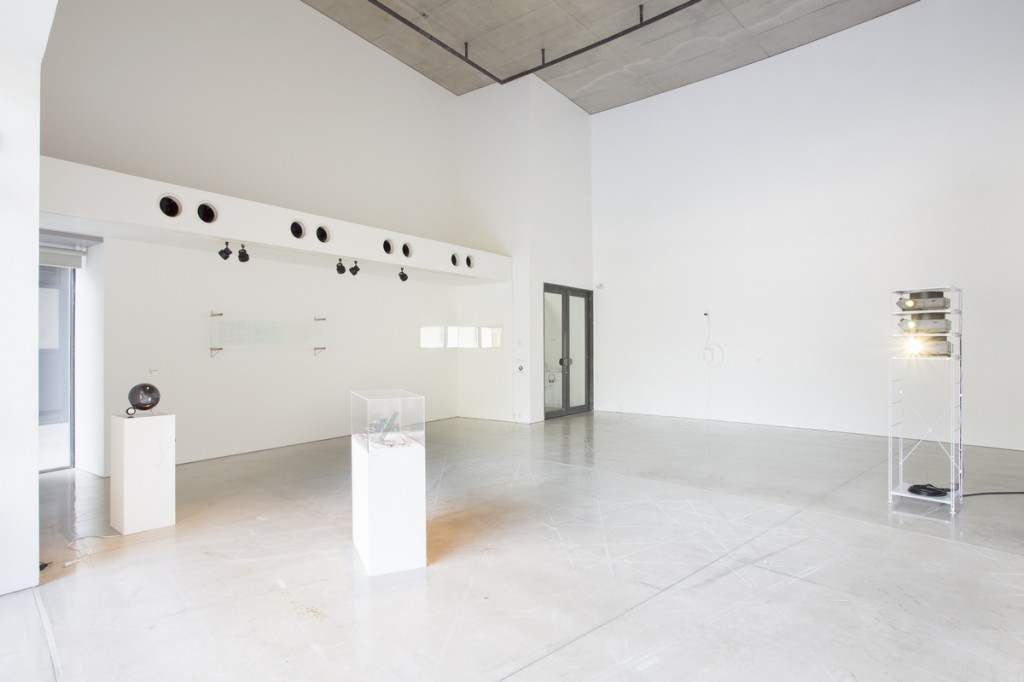
trans×form ─かたちをこえる
2013年7月27日(土)~9月16日(月・祝) 10:00-18:00 / 無料
air2013-2ja
八木良太
YAGI Lyota
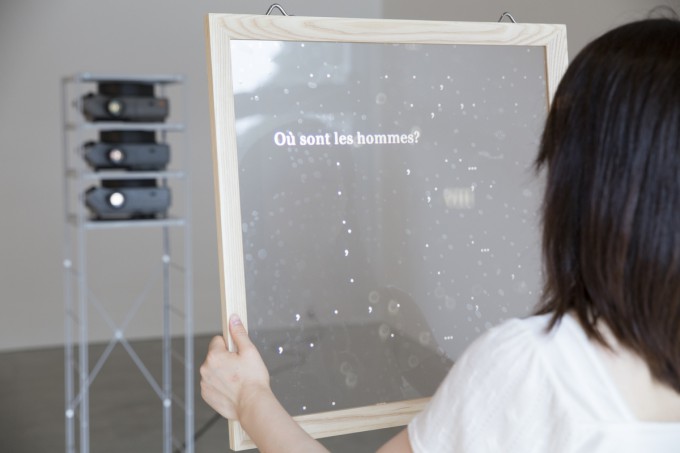
《Foci(星の篩)》、2013
サイズ可変
スライドプロジェクター3台、リアプロジェクションスクリーン(額)
※9月1日まで公開
撮影:小山田邦哉
美しい装置
近藤由紀
「trans×form かたちをこえる」における八木良太の制作と作品は、文字通り「かたち」を超えようとする試みであった。だが一方でそれは八木作品の特徴の一つとも言える。八木良太は、これまでも創作物によって表出的表現を行うというよりは、既製のシステムや道具を使いながら作品を構成し、その現れによって人間の知覚やそれを利用した工学的システムを浮かび上がらせるような作品を発表している。今回八木はより一層形にならない何かを捉えることを試みるために、かたち作る・作らないの狭間にある「焦点 Focus」をキーワードに新旧作品を合わせて展示を構成した。作品はそれぞれ光学的(《Foci》2013)、遠近法的(《Regenbogen(虹)》2006、)、音響的(《Sound Shower》2013)、心理的(《Timer》2005)、時間的(《Focus of Time(時間の焦点)》2013)という5つの切り口から焦点の合う・合わないが問われている。そこには全体として、見たいものしか見ない・聞きたいことしか聞かないという我々の制限的な知覚システムあるいは態度に対する批判的思考が通底しているように思われる。
光学的焦点をテーマに制作された《Foci(透明の森)》(2013)は、それぞれに異なる距離にピントが合わせられた三台のスライドプロジェクターが、大きく開かれたガラス窓に向かって像を投影している。背後に何もない明るい空間では何も見ることができないが[fig.1]、プロジェクターの前に磨りガラス状の特殊シートがはめ込まれたフレームを差し出すと、像が映る[fig.2]。単純な装置であるのだが、何もないと思っていた空間から、自らの行為によって何らかの像が取り出されるのは、奇妙な感覚である。焦点距離の違いから、フレームを持って前後に移動すると結ぶ像が場所によって変化し、移動によってフレーム内で動く画像は映像のようでもある。しかしここでは通常の静止している鑑賞者と動く映像という関係が逆転し、鑑賞者が動くことで静止像が映像として動き出す。ただそれだけのことなのに、映像は静止画の連続が錯視によって動いて見えるのだということが新鮮な驚きを持って浮かび上がってくる。スライドは展覧会開催当初、他の作品でも用いられたテキストの断片が使用されていたが、後半になると風景写真が使用された。風景写真になると、今度はそこに前景・中景・後景の関係が現れ、遠近法的焦点とともに、物事を立体的にとらえる私たちの視覚システムについても言及する。
体験型のこれらの作品は、実際に鑑賞者が作品を扱って鑑賞するのだが、その取扱方法は懇切丁寧に説明されるわけではない。だがそれは作品のインスタレーション的な完成度を第一義に考えてということではないだろう。八木の作品は、いつも生きていく中で当たり前のこととしてなされてきた事象を逆転させたり、少しずらしたりして提示する。そうした事柄は慣らされてしまっていたり、見えなかったりするが、一度それに気付くと宇宙や超越的な時空間といった広大で深遠な存在が身近に迫ってくる。八木の作品によってもたらされるのは、こうした当たり前だと思われている世界に対する新鮮な驚きである。だからこそその作品には鑑賞者の発見という要素もまた含まれるのであろう。
しかしだからといって作品はわかる人にわかればいいと言い放たれてはいるわけではない。今回の展示では導入として、《Timer》(2005)がギャラリー入口前の風所室に展示された[fig.3]。音が僅かに増幅される装置の上に砂時計が置かれたこの作品では、鑑賞者は周囲のノイズか砂時計の音か判断がつきにくいほど微かな音に集中しながら砂が落ちる5分間を聞き続ける。単調な音は意識を飛ばし、最後の砂の一塊が、ぼすっとひと際大きな音を立てて落ちる音ではっと我に返る。そうして見聞きする準備と微細な現象に対するウォーミングアップが済んだ鑑賞者は、訓練された発見者となって、ささやかな現象が備えられたギャラリーに足を踏み入れることとなる。
こうした仕掛けはそこここに設えられている。入り口すぐの壁脇に設置された《Sound Shower》(2013)の小さなシャワーヘッドには超指向性のスピーカーが内蔵され、ザーという音が絶え間なく流れている。超指向性であるがゆえにシャワーヘッドの下に立ってみなければ、その音はよく聞こえない[fig.4]。文字通り能動的に聞こうとしなければ聞くことができない作品であるが、シャワーヘッドという使用方法が明白な道具、敏感になった耳が僅かに捉えた水音と関連づけられる小さな音は、鑑賞者を自然とその下へと向かわせるだろう。見聞きする準備とは、ここでは聞きたいことしか聞かない、見たいものしか見ないという心理的な枷を外すことでもある。すなわちそれは作品展示の一連の流れによって心理的焦点についても言及しているといえる。
八木はしばしば作品にテキストを用いるが、この「テキスト」もまた見える・見えないの狭間にあるのかもしれない。《Regenbogen(虹)》(2006)は、7色に色分けされた文章が前後2枚のガラスに分解されてシルクスクリーンで印刷されている[fig.5]。ある地点からみれば統合されるようにずらされているため、ひとまとまりの文章として見るには、ある程度の距離をとらなければならない。だがその内容を読もうと作品に近づくと文字列はバラバラになり、文章としては読むことができなくなる。それは文字通り「虹」および「虹」を見ようとする人の行為と重ねられているのだが、一方でこの作品で採用されているテキストは、「虹」の現象について書かれたドイツ語の小説の一部であり、日本での展覧会でこれを読める人は少ない。鏡とガラスが直角に設置される《Der spiegel im spiegel(鏡の中の鏡)》(2005)は、鏡によって像が反転するため更に複雑な構造をもち、そこに書かれた文章はタイトル通り、反転して反転した非鏡像が写る奇妙な鏡に写るあるポイントからしか読むことができない(fig.6)。鏡が用いられたこの作品では、ドイツ人作家ミヒャエル・エンデの小説『鏡の中の鏡』から原語の文章が採用されている。どちらとも作品のタイトルがその出典を示しているが、それ以外の情報は特に明らかにされておらず、どちらも文章を読ませる意図は希薄である。
一方で文章が読めなくても、その内容がわからなくても、作品は成立する。文章のタイトルである『虹』も『鏡の中の鏡』もタイトルが既に詩的かつ指示的であり、作品と接続するにはそれでも十分であるからだ。だがもし最初からその文章の内容や書かれていることがわかっていたらどうだろうか。鑑賞者は、作品とそれらのテキストを結びつけて、深層的な解釈をするかもしれない。あるいは文章の内容に引っ張られ、叙情的な解釈をするかもしれない。だがおそらくそれは作家が意図することではないのだろう。八木は何かを表出したり、コンテンツの根っこになるような部分を作ったりすることにあまり興味がないという[1]。それらはあくまである状態を示すための素材の一部にすぎず、作品は現象にのみ開かれている。とはいえ、その意味内容は密やかに作品と呼応している。《Foci(透明の森)》(2013)では当初、他の作品で使用された文章のスライドが採用されていた[2]。それはサン=テグジュペリの『星の王子さま』からのいくつかのセンテンス(原語)と、点やカンマといった記号が抜き出されたスライドで、文章はますます分からなくなっている(fig.7)。点やカンマは星のようで、当初《Foci(星の篩[ふるい])》と題されていたこの作品は、プロジェクターの前にフレームを掲げて移動すると、何もない所に浮かび上がった3D宇宙空間をフレーム内に見るようだ。だがその出典が分かると、星との結びつきのみならず、王子さまがキツネとの別れ際に教えられた「大切なことは目に見えない」という言葉が否応なしに作品と結びついてくる。
このように叙情性や物語性が注意深く排されてはいるが、その作品はどこかロマンティックであり、表象的である。これを支えているのは、たとえ読めないにしても作品と文章が呼応していたように、作品を構成するあらゆる素材が隠喩的に扱われているからであろう。例えば八木はしばしば作品にレコード、カセットテープといった少し古い記憶メディアを使っている。スライドプロジェクターもそうだが、これらは記録した音や映像をテープや溝、フィルムといった物理的な物に変換する。溝にしろ、フィルムにしろ、そこには何かが記録された過去の時間をとどめた痕跡が同時に閉じ込められている。八木の作品でこれらのメディアは、再生する機能以外をほとんどはく奪されることで、閉じ込められた時間を強く暗示させる。
記録メディアのみならず、八木の作品ではガラス、砂時計、フレーム、氷などあらゆるものが背後に象徴的な意味を隠し持ちながら、目に見えない現象が喚起される装置が作られる。それは同時代的な事物で根源的な感覚を揺さぶり、世界に対する新鮮な驚きを取り戻す美しい装置である。
***
滞在制作作品
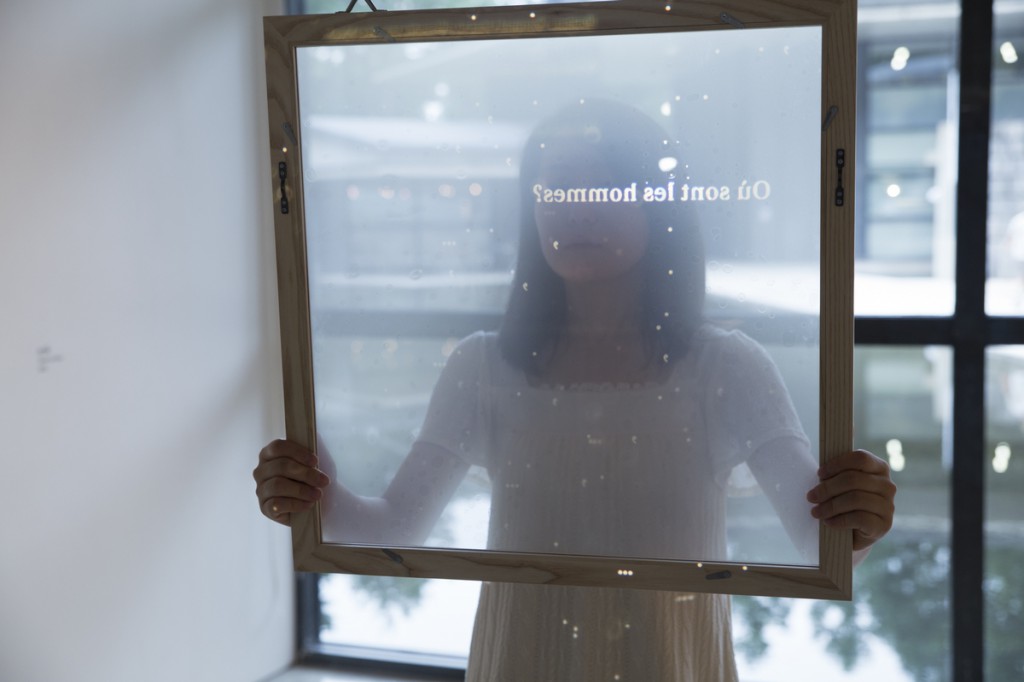
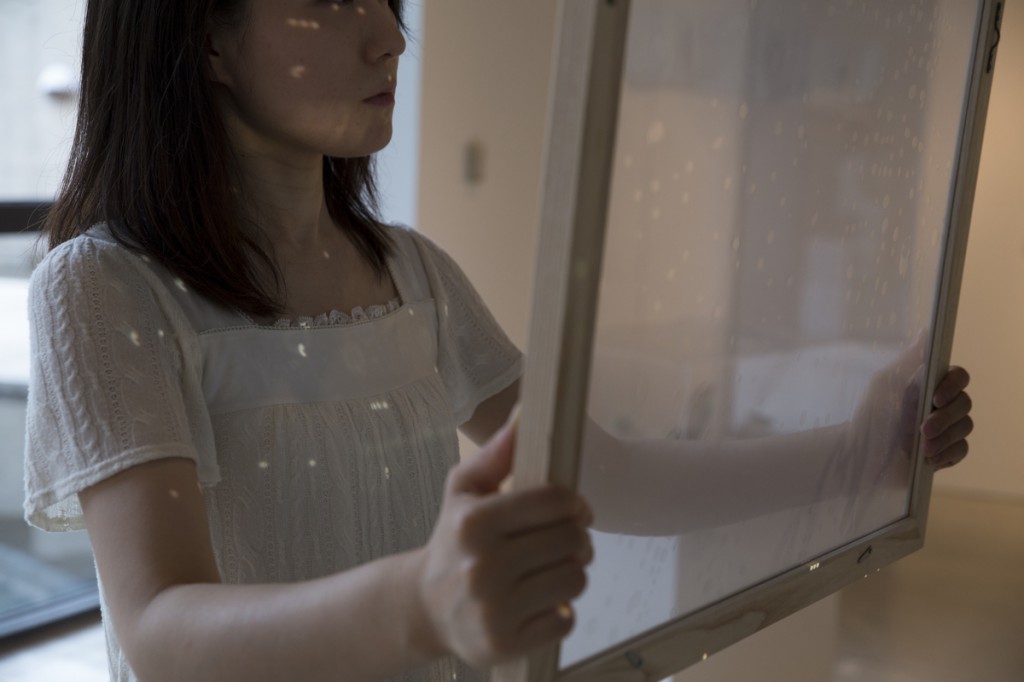
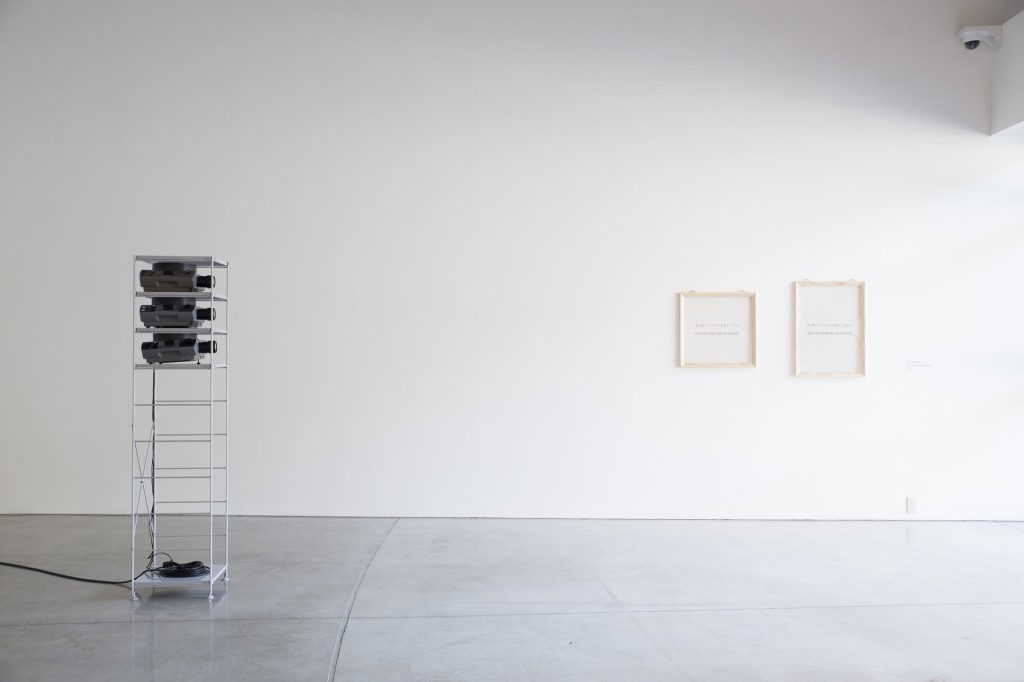 《Foci(星の篩)》、2013
《Foci(星の篩)》、2013
サイズ可変
スライドプロジェクター3台、リアプロジェクションスクリーン(額)
※9月1日まで公開
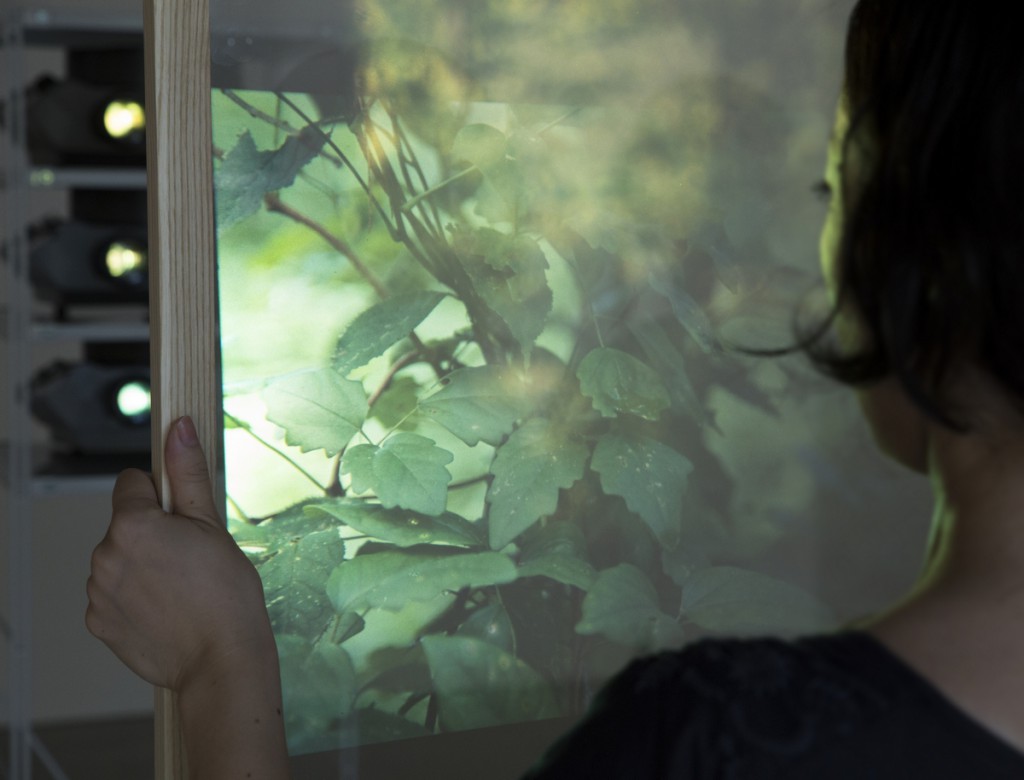
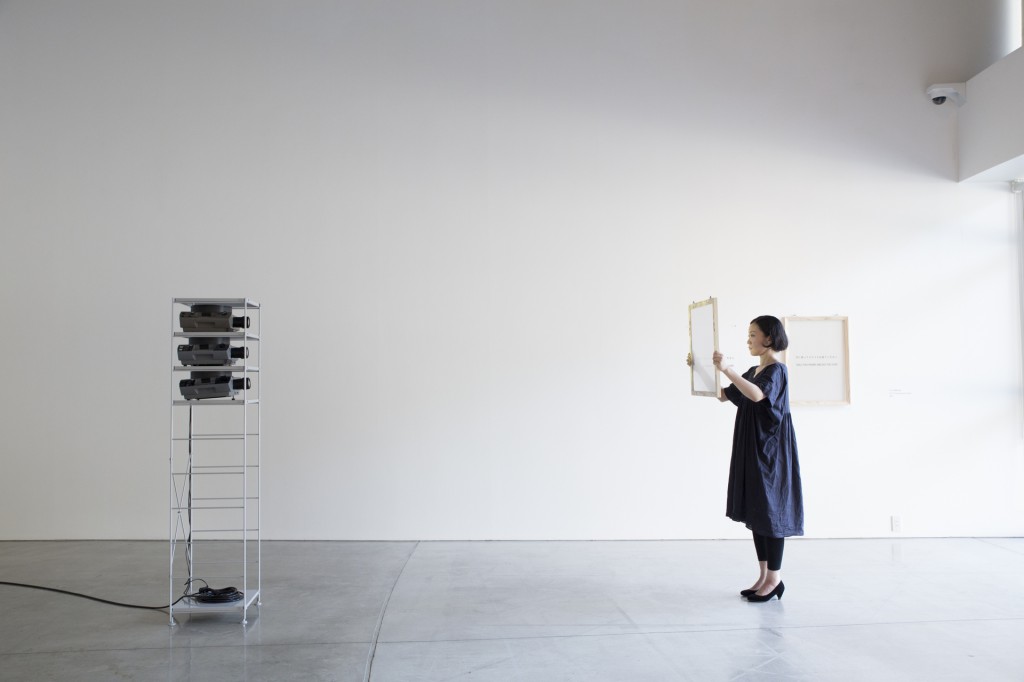
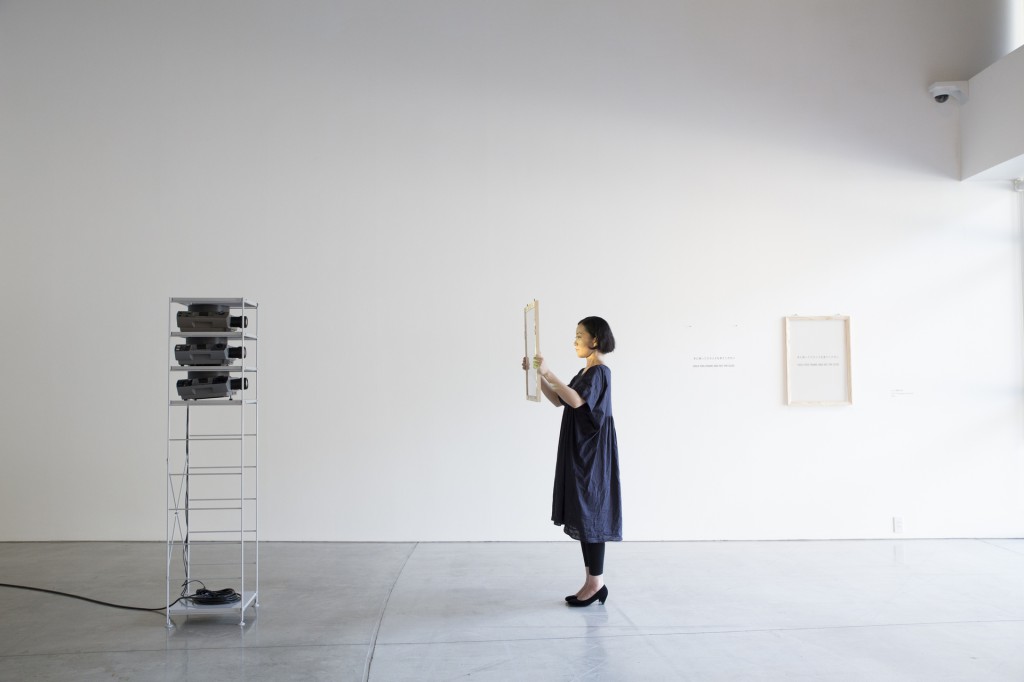
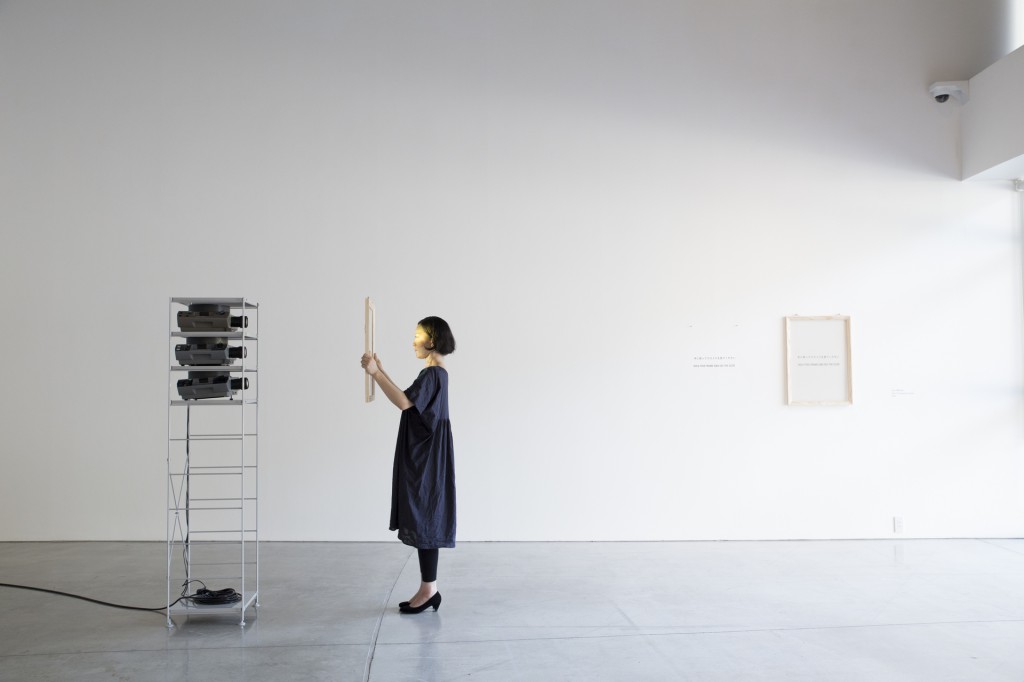 《Foci(透明の森)》、2013
《Foci(透明の森)》、2013
サイズ可変
スライドプロジェクター3台、リアプロジェクションスクリーン(額)
※9月2日より公開
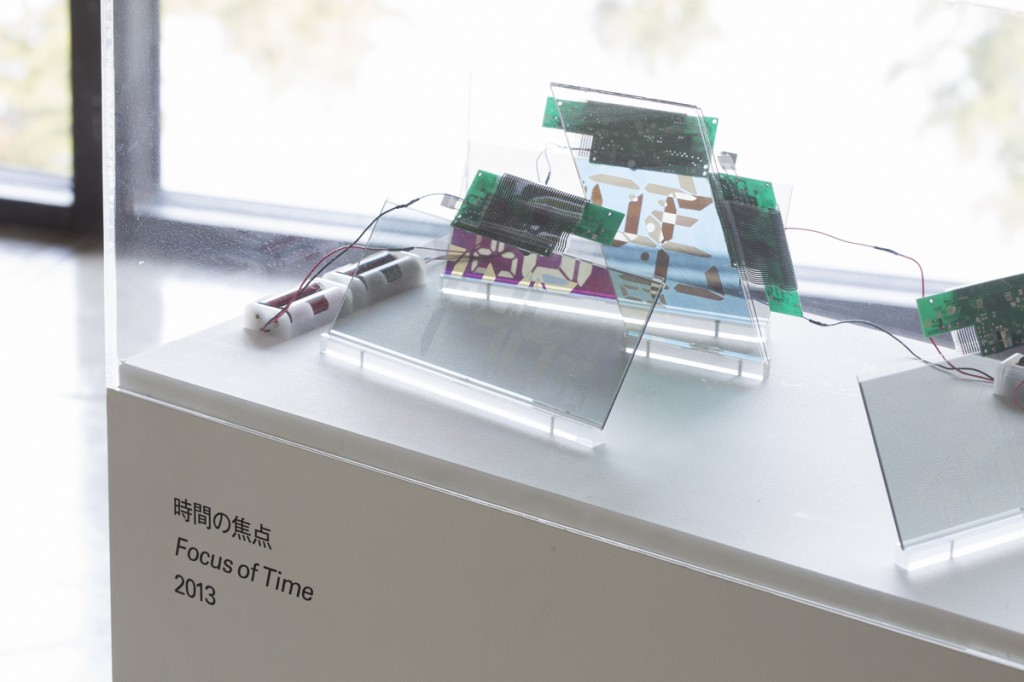
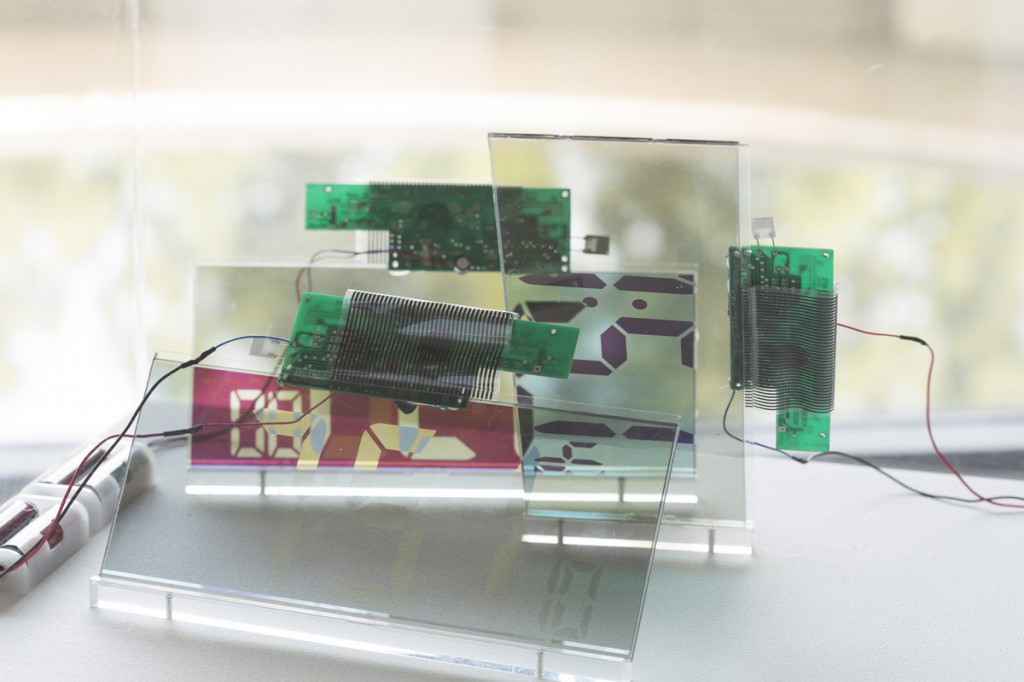 《時間の焦点》、2013
《時間の焦点》、2013
サイズ可変
液晶デジタル時計5台、偏光フィルム
撮影はすべて小山田邦哉
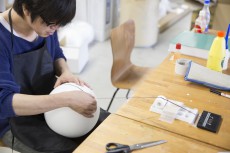
八木良太

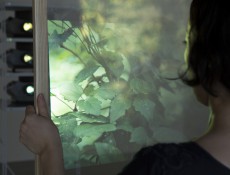
fig.1, fig.2《Foci(透明の森)》、2013
サイズ可変
スライドプロジェクター3台、リアプロジェクションスクリーン(額)
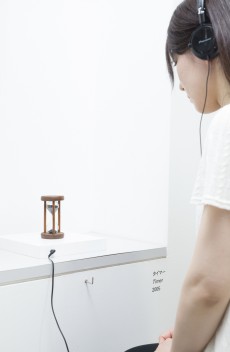
fig.3《タイマー》、2005年
W200×D200×H137mm
砂時計、マイク、イヤホン
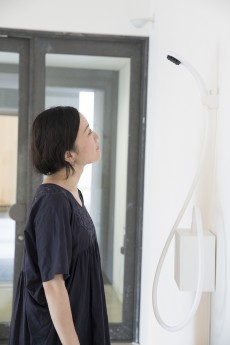
fig.4《Sound Sphere》、2013
サイズ可変
カセットテープ、テープレコーダー、モーター
※9月2日より公開
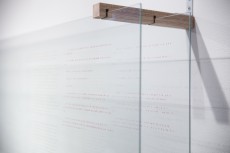
fig.5《虹》、2006年
W1644×D220×H389mm
ガラスにシルクスクリーン
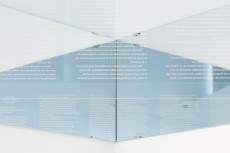
fig.6《鏡の中の鏡》、2005
W1000×D1000×H389m
ガラスにシルクスクリーン、鏡

fig.7《Foci(星の篩)》、2013
サイズ可変
スライドプロジェクター3台、リアプロジェクションスクリーン(額)
※9月1日まで公開
撮影はすべて小山田邦哉
trans×form
10:00am - 6:00pm, July 27 - September 16, 2013 / Admission Free
YAGI Lyota
八木良太

Foci (Sieve of Stars), 2013
Dimension variable
3 Slide projectors, Rear projection screen with frame
Photo: OYAMADA Kuniya
Beautiful Devices
KONDO Yuki
In this exhibition “trans×form”, YAGI Lyota attempted to transcend “form” literally through the production process and artwork itself, though it is generally one of the features seen in Yagi’s artworks. So far he has constructed and exhibited artworks, using ready-made systems and tools, to enable human perception and engineering systems to come out clearly, rather than creating representational expression through artworks. This time he has made an installation combining both new and past artworks together, with a keyword of “Focus” which exists between making and not making a form, in an attempt to further grasp something formless. Each artwork refers to whether being in or out of focus, from five different perspectives; optical one titled Foci—Transparent Forest (2013); perspective Regenbogen (Rainbow) (2006); acoustical Sound Shower (2013); psychological Timer (2005); temporal Focus of Time (2013). Taken altogether, every work pertains to critical thinking on our limited perceptual system or attitude, that is, we only see what we want to see and we only hear what we want to hear.
In the piece titled Foci—Transparent Forest (2013) under the theme of optical focus, three images are projected toward a wide panel of glass by three slide projectors which each have a different distance from the lens to its focus. Nothing can be seen in a bright space with nothing at the back (fig.1), but in holding out a frame with a special sheet of frosted glass in front of those projectors, images can be reflected in it (fig.2). It’s a simple device, but we feel a strange sensation when an image is produced out of space where we assume there is nothing, through our actions. As moving back and forward with the frame, we see the images change depending on the position, owing to each different distance from a lens to its focus, and so images moving within a frame affected by our movement seem like a movie. Here, the usual relationship between a viewer remaining still and moving images changes to the contrary; a moving viewer makes still images move like a movie. It’s very simple, but we realize in fresh wonder the mechanism of movies that optical illusion causes a series of still images to move seemingly. Although slides contained text fragments used in another art piece at the first half of the exhibition, they were changed into landscape photographs in the latter half. There is a connection among the foreground, middle distance and background in the landscape photographs, relating to our visual system to see things in a three-dimensional way with focus giving perspective.
Viewers can appreciate these experience-based artworks through dealing with them in practice, though they are not given careful explanation of how to deal with them. That may not be because Yagi takes completeness for an installation into primary consideration. Through his creation he presents a phenomenon usually considered a matter of course in everyday life by reversing or slightly changing it. Initially we are oblivious to the phenomenon, but once we become aware of it, vast and deep existence like the universe and transcendent time and space, closes in on us. Yagi’s works of art fill us with fresh wonder at the world taken as a matter of course. That is why discovery is an element of his artworks.
However, it does not mean that he only wants thoughtful viewers to understand his artworks. As the introduction to this exhibition, a piece titled Timer (2005) shows itself at the airlock entrance of the gallery (fig.3). An hourglass is put on a device to slightly amplify sound and the viewer can listen to falling sand for five minutes, concentrating their attention on the faint sound that they can hardly tell the difference between surrounding noise and the sound generated from the hourglass. The monotonous sound gets the viewer stupefied, and the last lump of sand plops as if making an exceptional sound that lets them recover their senses. Then the viewer is prepared to see and hear anything after the warming up to guide them toward meeting subtle phenomena. The viewer is now a trained detector, stepping in the gallery where subtle phenomena await him/her.
Such devices are laid here and there. A piece of work installed on the wall near the entrance, Sound Shower (2013), has a small showerhead with a parametric speaker, making a faint hissing sound continuously. Because of its parametric nature, you can only hear the sound clearly when standing under the showerhead (fig.4). Though the sound cannot be literally heard in case you don’t have active attitude toward hearing, the viewer is naturally lead to stand beneath the showerhead, due to the familiarity of this tool, and the faint sound associated with falling water that your sensitive ears barely react to. To get prepared to see and hear anything also means removing psychological limitations that we only hear what we want to hear and we only see what we want to see. That is to say, Yagi makes reference to psychological focus by exhibiting a series of artworks.
Yagi frequently uses text in his works, and the text may be also regarded as being between the visible and the invisible. As for Regenbogen(Rainbow) (2006), passages color-coded in seven colors are segmented and printed with silk-screen printer onto two sheets of glass put in the front/ rear direction (fig.5). Those two sheets coincide with each other when seen at the specific position, and therefore you need a certain distance to see complete sentences. But in case you approach the piece of work with intent to read the contents, letters in a row go all to pieces and cannot be read as a sentence. It’s literally associated with a rainbow, or the way that people behave when viewing a rainbow. The text in this artwork is also part of a German novel about a phenomenon of rainbow, wheich few viewers to the exhibition in Japan can translate. The piece titled Der spiegel im spiegel(The mirror in the mirror) (2005), has a further complicated structure. A mirror makes a right angle with a sheet of glass, and the reversal image is reflected on the mirror (fig.6). The written text can only be read at the specific point where a reversal image reflected on the mirror is reversed again on the very same mirror to make an unreflected image, as the title shows. In this work composed of a sheet of glass, Yagi takes the original text out of a novel with the same title, The mirror in the mirror, written by Michael ENDE, a German author. Although each title of both artworks shows the reference, no further information is revealed and both works have little intention to have a viewer read the text.
Even if you cannot read the text or understand contents, you can still appreciate the artwork. The title of the text, Rainbow or The mirror in the mirror, is poetic and suggestive enough to allow you to grasp the whole intention of the artwork. On the other hand, what if you could read the text and understand the content from the beginning? You might be lead to an in-depth interpretation through connecting the words with the artwork. Or the content of the text might draw you to a lyrical reading. But these are probably not the intention of the artist. Yagi says he is not so interested in representing something or composing a base for contents[1]. Those are just parts of materials to reveal a certain situation, and his artwork is intended only to develop phenomena. But in effect, the content of the text matches the artwork. Speaking about Foci (2013), at the beginning he used slides that show a passage used in another artwork[2]. There are, on each slide, several original sentences extracted from The Little Prince written by Saint-Exupéry and marks such as periods and commas selected from the passage, and so meaning of the text is harder to read (fig.7). As these periods and commas seem like stars, the artwork was titled Foci—Sieve of Stars at the beginning. While moving back and forward with a frame in front of the projectors, it feels like you are seeing three-dimensional outer space emerging from nothing. But, if you notice where the sentences are taken from, you will not only find connection with the star, but also spontaneously associate the artwork with words that the fox gave the prince when they separated; what is essential is invisible to the eye.
Thus lyricism and a story line are excluded carefully, but there is something romantic and representational about his artworks. This would be because all the components of artworks are dealt with metaphorically, like the case that the text matches the artwork even if a viewer cannot read it. For example, Yagi often uses obsolete media such as a disk record and cassette tape for his artworks. Of course including a slide projector, this media converts recorded sounds or videos into physical things like tape, groove or film. Whether groove or film, there is also traces stored inside of a past recorded. Using such media in his works strongly suggest the past stored inside, through being deprived of almost everything except playback function.
Yagi creates devices generating invisible phenomena with all things concealing symbolic meanings, like a sheet of glass, an hourglass, a frame, a piece of ice as well as recording media. The beautiful devices stir our primordial senses using contemporary things, and allow us to see the world in fresh wonder.
(Translated by Nishio Sakiko & Joe MARDELL)
***
Photos of the works made in ACAC


 Foci (Sieve of Stars), 2013
Foci (Sieve of Stars), 2013
Dimension variable
3 Slide projectors, Rear projection screen with frame



 Foci (Transparent Forest), 2013
Foci (Transparent Forest), 2013
Dimension variable
3 Slide projectors, Rear projection screen with frame

 Focus of Time, 2013
Focus of Time, 2013
Dimension variable
5 LCD digital clocks, Polarizing film
All photos are taken by OYAMADA Kuniya

YAGI Lyota


fig.1, fig.2 Foci (Transparent Forest), 2013
Dimension variable
3 Slide projectors, Rear projection screen with frame

fig.3 Timer, 2005
W200×D200×H137mm
Sandglass, Microphone, Earphone

fig.4 Sound Shower, 2013
Dimension variable
Shower head, Parametric speaker, MP3 player

fig.5 Regenbogen, 2006
W1644×D220×H389mm
Silkscreen on glass

fig.6 Der spiegel im spiegel, 2005
W1000×D1000×H389mm
Silkscreen on grass, Mirror

fig.7 Foci (Transparent Forest), 2013
Dimension variable
3 Slide projectors, Rear projection screen with frame
All photos are taken by OYAMADA Kuniya

